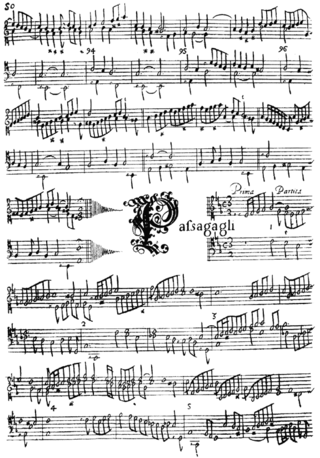
The passacaglia is a musical form that originated in early seventeenth-century Spain and is still used today by composers. It is usually of a serious character and is typically based on a bass-ostinato and written in triple metre.

Toccata is a virtuoso piece of music typically for a keyboard or plucked string instrument featuring fast-moving, lightly fingered or otherwise virtuosic passages or sections, with or without imitative or fugal interludes, generally emphasizing the dexterity of the performer's fingers. Less frequently, the name is applied to works for multiple instruments.

Trevor David Pinnock is a British harpsichordist and conductor.
In music, variation is a formal technique where material is repeated in an altered form. The changes may involve melody, rhythm, harmony, counterpoint, timbre, orchestration or any combination of these.
The siciliana or siciliano is a musical style or genre often included as a movement within larger pieces of music starting in the Baroque period. It is in a slow 6
8 or 12
8 time with lilting rhythms, making it somewhat resemble a slow jig or tarantella, and is usually in a minor key. It was used for arias in Baroque operas, and often appears as a movement in instrumental works. Loosely associated with Sicily, the siciliana evokes a pastoral mood, and is often characterized by dotted rhythms that can distinguish it within the broader musical genre of the pastorale.

Hilding Constantin Rosenberg was a Swedish composer and conductor. He is commonly regarded as the first Swedish modernist composer, and one of the most influential figures in 20th-century classical music in Sweden.

The Partita in D minor for solo violin, BWV 1004, by Johann Sebastian Bach, was written between 1717 and 1720. It is a part of his compositional cycle called Sonatas and Partitas for Solo Violin.
Arnold Atkinson Cooke was a British composer, a pupil of Paul Hindemith. He wrote a considerable amount of chamber music, including five string quartets and many instrumental sonatas, much of which is only now becoming accessible through modern recordings. Cooke also composed two operas, six symphonies and several concertos.
Wolfgang Friedrich Rübsam is a German-American organist, pianist, composer and pedagogue.
Karl Höller was a German composer of the late Romantic tradition.
Arnold Rosner was an American composer of classical music.
Nazario Carlo Bellandi was an Italian music composer, organist, pianist, and harpsichordist.
Pierre D'Archambeau born from Belgian parents, was an American violin virtuoso and pedagogue

The Chaconne in G minor is a Baroque composition for violin and continuo, traditionally attributed to the Italian composer Tomaso Antonio Vitali. A Dresden manuscript that may have been transcribed in the early 18th century is the earliest known version of the chaconne, but it was not published until 1867 when Ferdinand David arranged it for violin and piano. The origin of its composition has been debated, with some musicologists hypothesizing that the work is a musical hoax composed by David rather than Vitali. Léopold Charlier made significant alterations to the chaconne in the early 20th century, transforming it into a virtuosic, Romantic-style showpiece. It has been arranged by numerous other composers, including Hans Werner Henze, who used it as the basis for his work Il Vitalino raddoppiato (1977).






